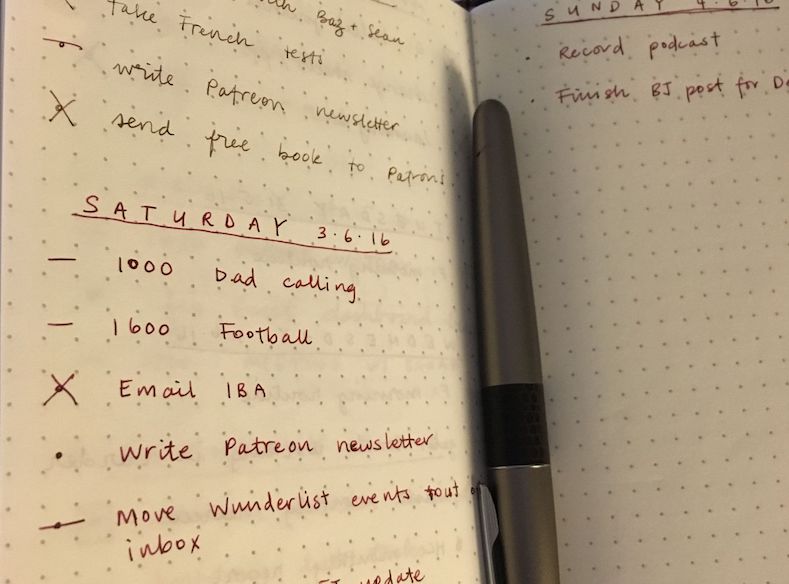People are Falling in Love with a Simple Productivity System that Just Uses Pen and Paper
People are Falling in Love with a Simple Productivity System that Just Uses Pen and Paper
I’m one of those people who is constantly testing out new productivity apps in the hopes that this is the technology that will transform my life for good. Each new app promises to make me more efficient than the last.
But I’ve never been able to find a method that quite beats the flexibility and simplicity of pen and paper. Most productivity methods force you to work their way, rather than adapting to suit your needs. Pen and paper, however, can be used any way you like. I’ve always wanted to find a system that balances this flexibility with enough structure to keep you organized.
That’s where the Bullet Journal system comes in. Created by designer Ryder Carroll, the system aims to give the humble paper notebook a little more structure.
The Bullet Journal consists of a few specific sections:
An index, in which you list the page numbers of any subject you want to find again later (using a notebook with pre-printed page numbers speeds up this process).
A future log, in which you keep track of upcoming events or deadlines for the next six months.
A monthly log, in which you note events and deadlines for a specific month, and a list of monthly tasks.
A daily log, in which you write down tasks, events, and notes per day. This is where you plan what to get done each day and work through your tasks.
Carroll gives an overview of how this works here:
The Bullet Journal’s main feature is rapid logging, which is used for the daily logs. The idea of rapid logging is that you can mix together notes, tasks, and events in the same place, and use different bullet points to distinguish between them. A task (“pick up dry cleaning”) gets a simple dot. A note (“Jack’s in town”) gets a dash. And an event (“happy hour with co-workers”) gets a circle.
Later, you can change your task dots depending on the status of the task. If you finished the task, you can turn the dot into an “X.” If you didn’t get it done, you can move it to a future day or month by rewriting it on a future page. To show the task was moved, you turn the dot into an arrow.

These simple bullets make the process of getting started—and sticking—with the Bullet Journal system fast and easy.
For me, one of the best parts of the system is the index. Instead of flipping through my notebook constantly to find the meeting notes I need, or that phone number I jotted down some time last week, I can use the index to record the page number of anything I might want to revisit later.
And it doesn’t matter if related notes end up scattered throughout the notebook, rather than grouped together. The index lets you fill your notebook from front to back without wasting pages or needing to estimate how much space you’ll need for anything.
Getting started
If you’re interested in testing out the Bullet Journal system, it’s easy to try without making a big time investment. You can use any notebook and pen you have lying around, so long as you add page numbers if they’re not already printed for you.
To start out, create an index page (you may want a few pages for this—Carroll sets aside four index pages in the official Bullet Journal notebook).
Next, create a monthly log for the current month. Write the month name at the top of the page, and the numbers for each day of the month down the left-hand side. Add the first letter of the day name (e.g. “M” for Monday) next to the dates, and then fill in any deadlines or events you have this month. Don’t forget to add the monthly log to your index.
Finally, open to the next blank page and start a daily log for today. Write today’s date at the top of the page, and rapid log any events on today, notes to yourself, and tasks you want to get done.
Keep your notebook close by and open to today’s page as you work. This way you’ll stay focused on what you need to work on, and you can quickly add new tasks or notes as they come to mind.
At the end of the day, create a new daily log for tomorrow and migrate any tasks you didn’t finish today that still need get done.
Like any no-frills notebook, the Bullet Journal method is still flexible enough that you can make it work the way you want. A quick look through the official Bullet Journal blog, or searching for “bullet journal” on Instagram or Pinterest, will show you how varied the system can become.
Some people use their notebook like an art journal, including sketches of what they ate for lunch or cartoons of memorable conversations. Others treat it like a scrapbook, pasting in concert tickets and wine labels. And still others stick with the barebones approach Carroll shares in his explainer video. Because Carroll designed the Bullet Journal to be both a productivity tool and a record of events and notes, it makes sense to add mementos, photos, or illustrations.
Personally, I use the Bullet Journal as a pure productivity tool: a way to keep track of my workload and plan my days. Using analogue tools has had the extra benefit of encouraging me to spend quiet time every night away from screens, reflecting on my day and planning for tomorrow. This process, and the simplicity of the Bullet Journal system, have helped me get things done without being overwhelmed by digital productivity apps.
Belle Beth Cooper/Quartz
Be the first to post a message!
